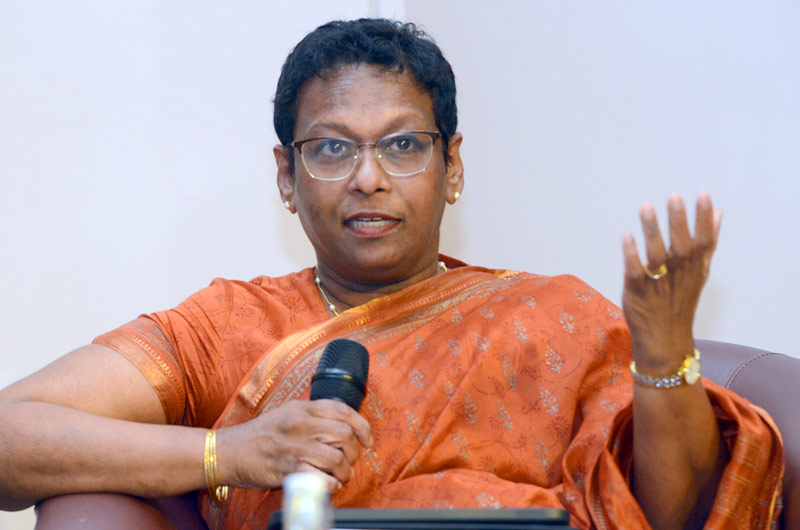Desired debt goal to remain elusive: Economist
Monday, 24 February 2025 05:41 – – 42

Advocata Institute Senior Research Fellow Dr. Roshan Perera
- Public debt to remain near 100% of GDP despite IMF-driven fiscal improvements says Advocata Institute Senior Research Fellow Dr. Roshan Perera
- Stresses urgency of economic reforms before debt repayments begin, with narrow window for action
- Opines sustained 6% growth over eight years needed for economic stability
- Calls for export-led growth strategy; exports have fallen from 33% of GDP in 2000 to just over 7% in 2024
- Asserts implementation key to drive growth
- Supports Budget proposals for flexible exchange rate, reduced trade barriers, economic zones, but warns past reforms failed due to poor execution
- Criticises Budget priorities, pointing out only Rs. 2.4 b allocated for investment promotion, while highways receive Rs. 400 b
- Says financial aid alone won’t solve SME challenges, suggests cooperative production model to enhance competitiveness
- Urges major shift in Budget focus, better resource distribution and stronger policy consistency to drive long-term economic growth
By Charumini de Silva
Advocata Institute Senior Research Fellow Dr. Roshan Perera last week said despite the improvements in fiscal management, largely driven by the International Monetary Fund (IMF) program, the country still faces a significant debt burden, with public debt projected to remain at nearly 100% of GDP, even under optimistic assumptions.
“Sri Lanka has a very short window to act before debt repayments begin,” she warned, sharing insights at the 2025 Budget Seminar organised by the Institute of Chartered Accountants of Sri Lanka (CA Sri Lanka).
Noting that the Government has set an ambitious target of 5% GDP growth for 2025, exceeding the long-term average of 4.5%, she said even this may not be sufficient. Dr. Perera opined that a consistent 6% growth rate over the next eight years is required to place the economy on a sustainable path. Central to this strategy is a renewed focus on exports, she said, highlighting that the Government has set a bold export target of $ 19 billion, necessitating a projected annual growth rate of 17%.
“In 2000, exports accounted for 33% of GDP, but this figure has since plummeted, with last year contributing just over 7%,” she added.
Dr. Perera attributed this decline to structural issues, including an overvalued exchange rate and a historically protectionist trade regime.
“Encouragingly, the Budget acknowledges these issues, with proposals for a flexible exchange rate and a national trade policy aimed at reducing barriers. Measures such as the removal of import taxes on raw materials, trade agreements, and the establishment of economic zones are all steps in the right direction,” she said. However, she remained cautious, pointing out that many of these proposals have appeared in previous Budgets, but failed in implementation.“The key is execution,” she stressed, reiterating that the country has a very short window to get this right.
Dr. Perera noted that countries that have successfully accelerated economic growth have done so on the back of strong Foreign Direct Investment (FDI) inflows, although in Sri Lanka, despite various proposals to attract investments, including economic zones and trade agreements, the actual Budgetary allocations for investment promotion remain relatively small.
“For instance, while industrial promotion has been allocated Rs. 8 billion and investment attraction Rs. 2.4 billion, these figures pale in comparison to the Rs. 400 billion earmarked for highways,” she explained.
Acknowledging that infrastructure development is important, Dr. Perera questioned whether such spending priorities align with Sri Lanka’s most pressing economic needs.
“We need to shift our Budget focus if we are serious about economic objectives,” she said.
Stating that the Budget includes various support programs for small and medium-sized enterprises (SMEs), she opined that financial aid alone will not solve their challenges.
She said one possible solution is a cooperative production model, which has worked in other countries — but its success will depend on proper planning and execution. Additionally, heavy regulations continue to be a major hurdle, especially for SMEs trying to expand or enter export markets.
“For the economy to recover and grow, there needs to be a major shift in how resources are distributed,” Dr. Perera said, insisting on the need for consistent policies, strong implementation, and better financial support for productive industries.
pic by Shehan Gunasekara





